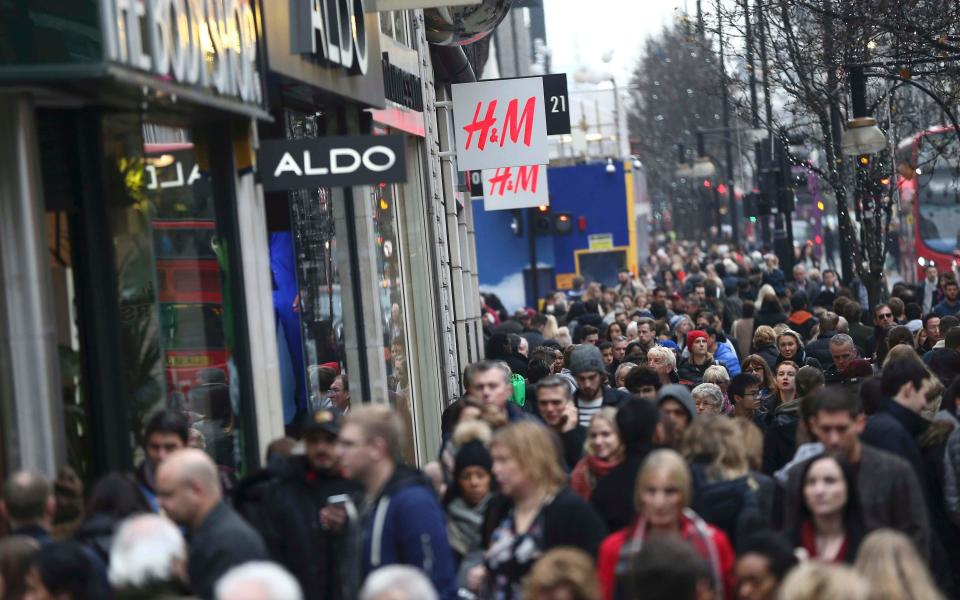How the UK retail sector is sailing into a perfect storm

The retail sector is struggling. Bellwether Next has returned to recession-stricken times with its first fall in profits since the recession and John Lewis, long held up as a bastion of the industry, is cutting jobs and its famous staff bonus in order to safeguard its future.
Meanwhile, a slew of smaller high street rivals, including Jones Bootmaker, Jaeger and Blue Inc, are shutting shops and being put up for sale as their owners look to secure a means of survival.
So what's causing the chaos?
1. Changing spending habits
While shopping used to be considered Britain's unofficial national sport, this nation of consumerists has switched from spending on clothes and shoes to leisure pursuits, such as eating out and holidays.
Despite discretionary income remaining the same, retail spending fell by 1.2pc last year, with fashion sales suffering a 2pc slump - the steepest decline since the credit crunch of 2008.
Fashion sales have slumped in the past year
2. Shift in shopping trends
When people do spend their money on retail purchases, increasingly they are shopping online with "clicks" rather than in bricks and mortar shops.
Smartphones and social media feed a demand for instant gratification that has played into the hands of youth-focused online retailers like Asos, Missguided and Boohoo, which are stealing sales away from their traditional rivals.

Their stellar growth is now heaping pressure on traditional retailers to capture this part of the market.
While store sales are stagnating, online sales grew by 15pc last year. They now account for around 18pc of total sales compared to just 2.8pc 10 years ago.
As a result, the retail sector is facing a dilemma between investing in expensive logistics in order to compete against their online rivals and investing in revamping their expensive store estate to lure in shoppers at a time of dwindling high street footfall.
3. Property costs (business rates)
Business rates continue to be one of the biggest millstones around retailers' necks. The Government will collect £25bn in rates this year with the retail sector paying the lion's share.
This year business rates are an even bigger burden because the Government is undertaking the first rates revaluation since 2010. Those companies that have seen an increase in their properties' rentable values will be in line for a shock rates jump.
The retail sector alone is forecast to face a £2.3bn hike in rates while shops in London will experience a rise equivalent to a 6pc rental increase.
Outside London and the south east, retailers that were due to have their rates bills slashed are now only going to have a small reduction, as the potential savings are being transferred into a £3.6bn pot to help offset the jump faced by others.
One of the biggest arguments against the business rates system is that it disadvantages retailers with shops because online players do not face the same level of property tax.
The Government has indicated that it is aware of the gulf between online and traditional players, but it is unlikely to act until the next rates bill in 2022.
Mapped: Business rates across England and Wales
4. Living wage rises
This April the National Living Wage rises to £7.50 for staff aged 25 and over. The retail sector, with its thousands of shops and warehouses, is the UK's largest private sector employer with 3m people.
According to experts at Deloitte, the National Living Wage increase is equivalent to a 2pc to 4pc increase in total wage bill for the retail sector.
Senior retail figures have warned that higher wages will mean the number of jobs will decline as lower-paid staff are replaced by robotic automation and it becomes too expensive to hire workers.
Companies have also complained that the rise means that they are also under pressure to lift salaries across the ranks too, not just for the lowest paid.
John Lewis recently said that it would have cost £3m to comply with the new living wage last year, but it ended up with a £33m bill to hand equivalent raises to its whole workforce.
5. Apprenticeship levy
The size of the sector means that retailers will pay around £235m of the £3bn levy this year. At a time when the sector is already suffering from bill increases and declining sales, the additional charge will be too much for some.

Most retailers argue they already run internship and training schemes, and the levy will curtail their interest in self-funding programmes in order to comply with a "box-ticking exercise".
6. Currency spikes
Since the EU Referendum vote, the pound has fallen by around 15pc against the dollar and 10pc against the euro, which is proving to be a huge headache for retailers.
Around 80pc of the retail sector sources its product in Asia and pays for it in dollars. As a result of foreign exchange falls, UK retailers face a 15pc jump in their sourcing costs.

In order to minimise the impact of foreign exchange, retailers now have to decide whether to pass the increased cost onto the shopper, which could dent sales, or absorb the higher sourcing charge, which could affect profits.
UK high street retailers will be at an even bigger disadvantage because their European rivals, such as H&M and Zara, will not be facing the same currency pressures - which means they can either choose to keep their prices low and grab even more market share, or strengthen their balance sheets with extra profit.
What now?
The perfect storm above means that around £3bn of profitability could be wiped off the sector, according to retail experts, who warn that the extra pressure will tip some companies over the edge.
The damage will take some time to trickle through the market as companies are now in the process of making difficult decisions about jobs, shop prices and how many stores they think they should have in this brave new era of retail.
But the British Retail Consortium has estimated that there will be 8,073 fewer shops by 2020, putting 80,000 jobs at risk.
Some restructuring experts think it will be even higher.

 Yahoo Finance
Yahoo Finance